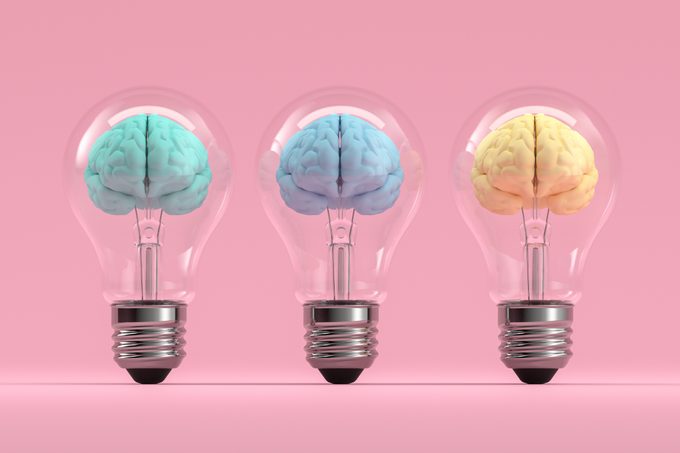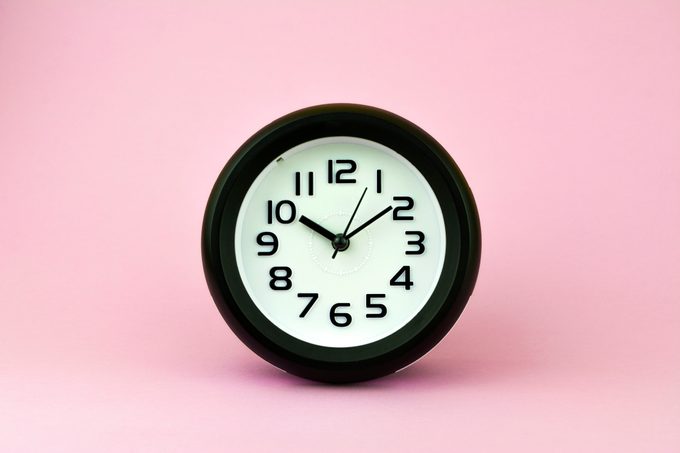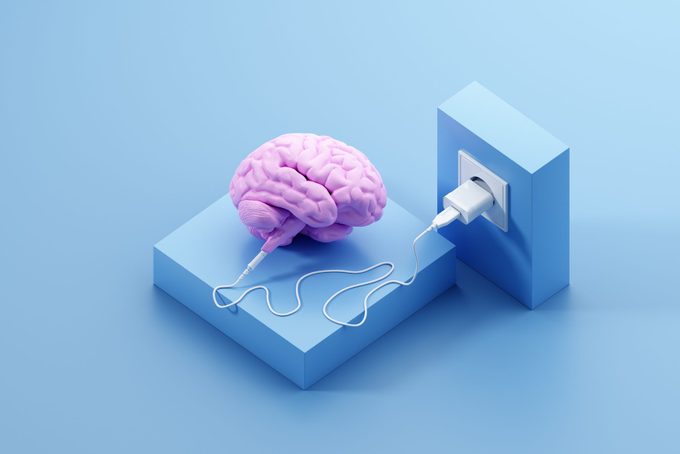[ad_1]
Bad habits: We all have ‘em. Although quitting them for good can feel overwhelming, habit-breaking becomes less intimidating when you know what to expect—and how long it takes to break a habit.
Nail-biting, procrastinating, staying up too late, checking social media repeatedly—these are just some of the bad habits we wish we could quit. But why isn’t it as simple as deciding to stop? And how long does it take to break a habit, anyway? Unfortunately, it’s not as easy as flipping a switch: Our brains have ingrained these behaviors, and according to science, it takes time and effort to get rid of them. But it’s not hopeless: We asked some habit experts to give us their insider tips on how to break habits so they don’t come back.
Why is our brain so good at forming habits to begin with? “Habits form when we repeat a behavior at such a high frequency in such a consistent way that it starts to become automatic and no longer requires conscious deliberation,” says behavioral scientist Katy Milkman, a professor at the University of Pennsylvania’s Wharton School and author of How to Change. “Think about the automaticity of shampooing your hair or making coffee in the morning; you don’t have to deliberate about where you’ll find things or how you’ll use the tools—you just do it mindlessly.”
These are good habits, but the problem comes in when the habit affects you in a negative way, making it “bad.” Wasting time makes you stressed later. Forming unprofessional work habits could get you fired. And constantly checking your phone distracts you from moments of joy with your kids. But with a little help on how to set goals for habit-breaking, a positive attitude and tricks from our experts (think: habit stacking), you can learn how to change these bad behaviors for good.
Get Reader’s Digest’s Read Up newsletter for more habit tips, humor, cleaning, travel, tech and fun facts all week long.
What are habits?

The American Psychological Association defines a habit as “a well-learned behavior or automatic sequence of behaviors that is relatively situation specific and over time … is performed with little or no conscious intent.” Basically, it’s a repeated behavior you don’t think about doing. So you might find yourself constantly twirling your hair, a “bad habit” that leads to split ends, or always putting your keys down randomly without thinking about it, a bad habit that forces you to search for them later.
But habit-forming isn’t usually bad—in fact, it’s a really helpful way for our brains to work more efficiently. “The reason we think our brains are so good at building habits is that they are usually a very good thing because they prevent us from having to think about the things that we do regularly in the world,” says neuroscientist Russell Poldrack, a professor at Stanford University and author of Hard to Break: Why Our Brains Make Habits Stick.
He gives the example of driving to work, with all its complex decisions, such as which pedal to press and when, and which route to take. “But when we are driving to work, we rarely think about any of these things because once we have learned the route, our habit system takes over,” he says.
This frees up our brains for more important matters. “This is usually a very good thing,” he says. “Until it goes wrong.”
How habits form
Habits are so powerful because they are formed through connection changes between nerve cells in the parts of the brain involved in choosing our actions, Poldrack says. “When we choose an action and it has a positive outcome, then that leads to stronger connections between the nerve cells that caused that action, which will make that action occur more often in the future,” he says. In other words, each time you check your email after your alarm goes off, you’re forming stronger nerve cell connections in the brain and making it more natural to check your email upon waking each morning.
“Another important part of habits is that they are often triggered by a specific stimulus in the world, such as the smoker who is doing well at resisting in their daily life until they walk into a smoky bar and are compelled to have a smoke,” he says. This “habit loop” is set off by a cue, or trigger, which tells the brain to perform the habit, which leads to our reward.
Good vs. bad habits
Good habits are sprinkled throughout our day: washing our hands after we go to the bathroom, putting on our seatbelts when we get in the car or flossing our teeth before bed. But whereas we might not immediately see the payoff for these actions, “what makes a habit ‘good’ or ‘bad’ is usually whether there is some kind of short-term reward involved,” Poldrack says.
Most of the things we consider bad habits also involve inputs to our brains that we haven’t evolved to handle. A major player in this process is dopamine, the feel-good chemical responsible for the changes in nerve connections in the brain that make habits. “Drugs, foods and social media information all seem to hack into the brain’s dopamine system, driving it in ways that our ancestors never experienced,” he says.
Even with bad habits we consider less serious than, say, taking drugs or over-imbibing on alcohol, we get a more immediate reward than we do with our good habits—even if we’ll pay for the action later. The pleasure of binge-watching a TV show is swift, even though we know we’ll be tired the next day.
Types of habits
Although we’re probably most familiar with addiction habits like smoking and drinking, and health habits like exercising or eating, there are many other types of bad habits. There are those sometimes disgusting habits having to do with our body, such as burping, picking our nails or picking our nose. There are sleep habits like staying up too late, and money habits like overspending or forgetting to pay bills. And there are work habits, including procrastinating with poor time management or being a workaholic.
According to a 2022 YouGov survey, the most common bad habits Americans have had at some point in their lives are not exercising enough (65%), not saving enough money (61%), procrastinating (56%), sleeping too little (52%) and staying up late (49%). In addition, “many of us have emotion habits in which we get emotionally triggered by a particular person or behavior,” Poldrack says. These can become dangerous relationship habits we want to change.
Are habits different from routines? “I’d say that routines are a kind of habit,” Poldrack says. But there’s a subtle difference: Routines still require more conscious thought to perform. So for example, “a person with Alzheimer’s disease who has trouble remembering things from moment to moment might still be able to play the piano well,” he says.
How long does it take to form a habit?
Unfortunately, the answer to how long it takes to form a habit is not a one-size-fits-all explanation. “There is no single answer to this question,” Poldrack says. “One published study followed people as they tried to create new habits, like eating fruit before lunch or running before dinner, and found that it took people anywhere from 18 to 254 days to turn the new behavior into a habit.”
This small, oft-cited study, published back in 2009 in the European Journal of Social Psychology, found the participants averaged 66 days to form a new habit, so this is the statistic you’ll see most often. Another newer study published in 2021 found participants took a median of 59 days to form a new habit, so the original research could be accurate. Still, as there are so many variables and the research isn’t super robust, it’s best not to count on a specific time frame, as it could take anywhere from a few weeks to more than six months.
“There is no magic number of days in which we form a habit—the idea of a magic number is a myth,” Milkman says. Her research shows the length of time may also depend on the habit in question. After all, writing in a gratitude journal nightly and spending an hour sweating it out in the gym aren’t habits of equal weight.
In a forthcoming paper accepted for publication in the journal Proceedings of the National Academy of Sciences, Milkman and her collaborators looked at the speed at which two different behaviors became habitual: gym visits and hand sanitizing by caregivers in hospitals. “These are really different behaviors—one is much more complex than the other, one is done many times a day while the other isn’t,” she says. “And not shockingly, the average number of days it takes people to form what looks like a habit around hand sanitizing [a median of 36 hospital shifts] is far smaller than the average number of days it takes people to form what looks like a habit around exercising [a median of 198 days].”
New habits are difficult to form purposefully because they require a cue and a reward. “The problem is that new habits don’t get triggered by the world, so it’s easy to just forget to do them, especially when we don’t find them pleasurable,” Poldrack says. Even if you’re looking to form new habits that’ll help you be happier at home, set boundaries or be more productive, all of which have positive aspects, they’re simply not easy to rewire in the brain.
Is it true that it takes 21 days to break a habit?
Unfortunately, not exactly. The idea that it takes 21 days to break a habit came from Maxwell Maltz, a plastic surgeon in the 1950s who observed patients getting used to changes in their face and body starting around 21 days, a theory he explored in his 1960 self-help book Psycho-Cybernetics. Over the years, his estimation of a “minimum of 21 days” became shortened in popular culture to just “21 days.” But his theory didn’t have scientific evidence to back it up—plus, it was actually about getting habituated to new circumstances, not breaking habits.
Another popular take on the 21-day estimate is the 21/90 rule, which states that it takes 21 days to change a habit and 90 days to make it permanent; but likewise, the origins of this rule seem to stem from Maltz and are especially murky. Another urban myth is that it takes 30 days, popularized in self-help and inspirational books. None of these pop theories, though, have scientific research behind them.
How long does it take to break a habit?

OK, so it doesn’t take 21 days to ditch a bad habit. But exactly how long does it take to break a habit?
Our experts say there isn’t a magic number to answer “How many days does it take to break a habit?” The amount of time—and the amount of success—in solving the “How long does it take to break a habit?” riddle depends on several factors.
“The research on breaking habits shows that it can be exceptionally difficult, depending on the habit,” Poldrack says. “Studies of people trying to stop drinking alcohol or smoking have shown that after one year, only about one-third of the people who tried to quit have remained abstinent. This fits with other research from animals that suggests that old habits never go away; they are always lurking in the background, waiting to come back.”
The problem of “present bias”
Just because old habits never die doesn’t mean we can’t change our behavior—it just can be difficult. “There are a lot of forces working against us when we try to break a bad habit, though it’s quite easy to break good habits. If you decide you want to stop going to the gym, it will not be a challenge for most people,” Milkman says. On the other hand, “if you decide you want to stop biting your nails or smoking or swearing, well, now you’re in trouble.”
Why is this? Blame our brain’s reward system. “One reason those bad habits are hard to break is that they tend to be instantly gratifying but bad for us in the long run, and we’re wired to overvalue instant gratification in the heat of the moment and undervalue long-term rewards,” she says. “This is called ‘present bias.’”
That’s why we all feel good about committing to go to the gym tomorrow, quit smoking tomorrow or do a digital detox tomorrow—that’s the future, and that’s when we would get the rewards, Milkman says. “But doing it now sounds hard because it won’t be instantly gratifying,” she says. “The problem is that when tomorrow becomes today, we still don’t want to do it—we want to put it off again.”
The hardest habits to break
Obviously, habits that involve chemical addiction, such as smoking, drinking or drugs, are dramatically harder to stop than other habits, Milkman says. “There you have a chemical dependency teaming up with present bias to work against you,” she says.
But there are other factors that make any habit more difficult to break, including how long you’ve been doing it and how strong your motivation to stop is. For example, one study showed greater motivation to quit smoking among participants if it was affecting their kids’ health, which taps into our deep purpose in life.
“There is also some evidence that habits reinforced by your environment are harder to break,” Milkman says. Say you walk by a doughnut shop every morning on your way to work and have a habit of picking up a cruller. You’d like to break that habit, but every morning, the doughnut shop beckons on your commute. “That’s likely to be a harder habit to kick than a doughnut habit that requires you to go out of your way to stop by a doughnut shop, which wouldn’t already be in your natural path with a cue enticing you to indulge,” she says.
Sustained change
There simply isn’t conclusive scientific research to answer “How long does it take to break a habit?” Studies on habit-breaking or formation often use a time period of around two to three months, and they see some change within that time.
The good news: “The longer we sustain a habit [change], whether it’s three days, 21 days or 90 days, the more likely we are to keep the momentum up,” says clinical psychologist Lauren Cook, author of the forthcoming Generation Anxiety. “We particularly dislike breaking a streak, and the longer the better. So while 21 days certainly solidifies more long-term gains where we can see the benefits of stopping an unhelpful habit, the more time we put in even beyond this, the better.”
The specific length of time can vary per person, but you’ll want to let enough time pass that you’ve begun to buy into this new change and it starts to feel automatic, she says. Craft that goal-setting vision board with your new habit in mind, but plan on it taking at least several months to stick.
Tips for breaking bad habits

Once we understand how habits are formed, we can use the same principles to overcome them. “The best way to break habits is by changing your incentives and environment to make it less rewarding and more uncomfortable to enact your bad habit,” Milkman says. Here are the specific tips our experts suggest.
Be self-aware
First, you need to identify the habit you want to break—which sounds deceptively simple—and your trigger for it. “Denial may rear its ugly head, but awareness is key here,” says Helene Lerner, author of Time for Me: Self-Care and Simple Pleasures for Women Who Do Too Much. “To stop doing something that is, in fact, sabotaging you, you must be aware you are doing it.”
From there, you can work on the context around your habit. For example, if you know you engage in a bad habit when you’re stressed, you can work to avoid stress as well—say, by setting some non-negotiables in your work life.
Don’t rely on self-control alone
Breaking a habit is not just a question of wanting it enough. “Surprisingly, motivation is not enough, because motivation will inevitably wane,” Cook says. After all, if all it took to break a bad habit was to want to break it, it would be easy! Unfortunately, our brains are hardwired to fight against changing our habits.
“So we need more than willpower,” Milkman says. “We need tools to help us follow through and overcome our present bias.”
Change your environment
One extremely effective tool for changing a behavior is to avoid places and things that remind you of your habit. “The most important tip is to understand the situations or stimuli that trigger the habit, and change your environment to reduce your exposure to those situations or stimuli,” Poldrack says.
Don’t be afraid to try new things! Instead of passing by that doughnut shop, for example, take a different route to work—out of sight can sometimes mean out of mind.
Avoid your trigger
Another way to disrupt the cues that trigger your habit is to force yourself to go out of your way to engage in it. “For instance, if your habit is eating too much ice cream at night, you could make sure there is no ice cream in your house,” Milkman says. “So now you’ll have to walk or drive to the store to engage in your bad habit, and that friction might be enough to slow you down or prevent indulgence.”
Start small
If you set the bar too high, you’ll be setting yourself up for failure—so aim for a small habit change instead. “Set a goal to stop or shift a behavior for a week, then two weeks. This allows you time to get buy-in from yourself,” Cook says. “It can be a lot more insurmountable if you’re telling yourself that you need to change a behavior ‘forever.’ Instead, take those baby steps so that you can get some confidence back that change is in fact possible.”
You also can start with just a tiny tweak to your habit. So if you want to get up earlier, begin by getting up just five minutes earlier. Once that becomes easier, move to 10 minutes, then 15.
Use the buddy system
Research has shown that accountability with another helps change behaviors. “It’s useful to set up in advance a buddy system, agreeing to make that call to a friend when you want to engage in your bad habit,” Lerner says. Support groups can be beneficial as well—that’s part of what’s made AA so effective at helping people stay sober, but the same principle can work for other everyday habits too.
“It’s always helpful to have a support system in place that can hold you accountable,” Cook says. After all, what is community if not a support system?
Declare your intentions
Saying out loud what you’re trying to do, and sharing it with others, also makes it more real. “Name the change with others—if you keep it to yourself, you’re much more likely to give up on yourself,” Cook says. “Instead, if you’ve declared the change to others, you feel much more responsible, not only to yourself but to the people you’ve shared the change with.”
You can share your goals with friends and family members, but don’t be afraid of talking to strangers about your habit—on social media, that is. Trying a popular online 30-day challenge may start you on your new habit change if you post daily check-ins.
Go for digital accountability
You don’t necessarily need an actual person to help motivate you: An online tool might act as a “commitment device” as well. “Commitment devices are a tool you can use to act like your own parent or boss—you set up incentives to penalize behaviors you’ll be disappointed in yourself for enacting. They’re remarkably effective,” says Milkman. “For instance, you might literally set up a fine you’ll have to pay if you indulge in your bad habit. You can go to a website like Stickk.com or Beeminder.com and put money on the line that you’ll have to forfeit if you, say, go on social media for more than an hour today.”
Think positively
If you think you’ll fail, you probably will. “Many of us have a fixed mindset where we believe that we simply cannot change. Giving up on ourselves with this makes failure almost inevitable,” Cook says. “Instead, start to believe that it could be different for you. Hold a hope that you can shift your behaviors and that you’re more flexible than you’re giving yourself credit for.”
Embrace the power of positive thinking. Having a growth mindset instead of a fixed one can be a useful way of looking at behavior change.
Tempt yourself
As Poldrack says, old habits may not really ever go away. But if you want to replace a bad habit with a good one—say you want to get outside for walks instead of plopping on the couch after work—pair the new habit with something new and enjoyable that you don’t already get to do. Been dying to listen to that popular podcast? Combine the fun experience of listening to the podcast with your new walking habit.
Milkman calls this “temptation bundling.” It’s like a little reward for your new habit that may make your old one less appealing.
Pair a new habit with an old one
You can bundle an already established good habit with a new one, called habit stacking. Let’s say you’re never quite able to drink the recommended amount of water each day. You can decide that after you brush your teeth (an established good habit), you’ll have a glass of water (a new habit).
Though habit stacking is a smart way to start good new habits, it’s also a handy tool if you want to break a bad habit. You can use it to replace a bad habit with a similar but better one, says Milkman. For example, instead of having an afternoon soda if you’re trying to cut down, have a seltzer instead.
Embrace discomfort
At first, it might feel strange to go outside your comfort zone and try something different, like practicing meditation when your alarm trills every morning. But don’t let that dissuade you.
“Instead, you need to embrace discomfort,” Cook says. “We are so hardwired to seek comfort, and this leads us crawling back into bad habits. Instead, lean into the discomfort of change and reward yourself in other ways for being willing to try a new way of being.”
Make a fresh start
When your environment has changed completely—such as when you’re on vacation or have just moved—it can be easier to form new habit patterns and break old ones. But you don’t have to sell your house to find that perfect moment for change.
“Fresh starts are just moments when we’re more open to change, so you might look for an upcoming date on the calendar that feels like a fresh start, like a birthday or even a Monday,” Milkman says. “Some people will find it easier to start pursuing a goal like breaking a bad habit on a fresh start date.”
There’s a reason “new year, new you” is the theme of each and every January: We tend to think of beginnings as a time to make a fresh start.
Accept setbacks
Don’t let one slip-up give you an excuse to quit quitting. “It’s important to not be too hard on yourself if you try and fail to break a habit,” Poldrack says. “It happens to all of us, and for good reason, as our brains are ‘habit machines’ that combine with the strong rewards of the modern world to make it very difficult to quit.” Keep trying to increase your likelihood of success.
Sources:
[ad_2]
Source link





